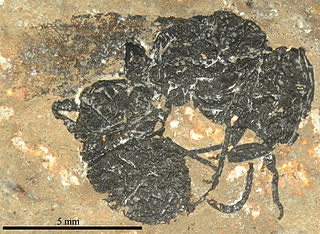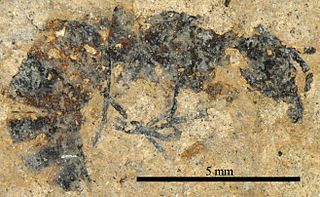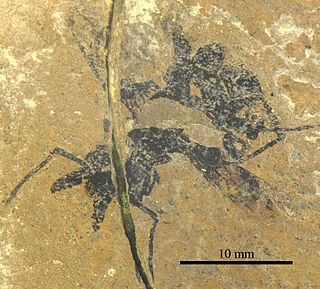
Ponerinae, the ponerine ants, is a subfamily of ants in the Poneromorph subfamilies group, with about 1,600 species in 47 extant genera, including Dinoponera gigantea - one of the world's largest species of ant. Mated workers have replaced the queen as the functional egg-layers in several species of ponerine ants. In such queenless species, the reproductive status of workers can only be determined through ovarian dissections.

Adetomyrma is a genus of ants endemic to Madagascar. Workers of this genus are blind. The type species Adetomyrma venatrix was described in 1994, with the genus being an atypical member of its tribe, the Amblyoponini. This tribe includes the Dracula ants, members of which can feed on the hemolymph of larvae and pupae.

Amblyoponinae is a subfamily of ants in the poneromorph subfamilies group containing 13 extant genera and one extinct genus. The ants in this subfamily are mostly specialized subterranean predators. Adult workers pierce the integument of their larvae and pupa to imbibe haemolymph, earning them the common name Dracula ant.

Myopopone is a genus of ants in the subfamily Amblyoponinae. The genus contains two species, one extant and one fossil. The type species Myopopone castanea is known from the Oriental and Indo-Australian regions, and China. The fossil species, Myopopone sinensis, is known from the Early Miocene.

Prionopelta is a genus of ants in the subfamily Amblyoponinae. Of its 15 species, four are known from Africa, five from the Americas and six from the Indo-Pacific region.

Mystrium is a rare genus of ants in the subfamily Amblyoponinae. First described by Roger (1862) with the description of the queen of M. mysticum, the genus contains 14 species, all of which occur in the rainforests of the Old World with over half of the species endemic to the Malagasy region.

Onychomyrmex is an Australian genus of ants in the subfamily Amblyoponinae. Its three species are known from eastern Queensland, Australia. Although not true army ants, Onychomyrmex species display an army-ant life style, including group predation and nomadism.

Stigmatomma pluto is a species of ant in the subfamily Amblyoponinae. The species was first described as Amblyopone pluto by Gotwald and Levieux in 1972 and moved to the genus Stigmatomma in 2012.
Stigmatomma scrobiceps is a species of ant in the genus Stigmatomma. It was described as Bannapone scrobiceps by Guénard et al. in 2013, based on two specimens collected in Yunnan Province, China, and placed as the second species in Bannapone. It was moved to Stigmatomma by Ward and Fisher (2016).

Casaleia is an extinct genus of ants in the formicid subfamily Amblyoponinae described by Pagliano & Scaramozzino in 1990 from fossils found in Europe. The genus contains four species dating from the Eocene to Miocene, Casaleia eocenica, Casaleia inversa, Casaleia longiventris, Casaleia orientalis.

Pachycondyla? messeliana is an extinct species of ants in the formicid subfamily Ponerinae described by from a fossil found in Europe. P.? messeliana is one of six Lutetian Pachycondyla species.

Pachycondyla petiolosa is an extinct species of ant in the formicid subfamily Ponerinae described by from a fossil found in Europe. P. parvula is one of six Lutetian Pachycondyla species.

Pachycondyla petrosa is an extinct species of ant in the formicid subfamily Ponerinae described from a fossil found in Europe. P. petrosa is one of six Lutetian Pachycondyla species.

Protopone is an extinct genus of ants in the formicid subfamily Ponerinae described from fossils found in Europe and Asia. There are seven described species placed into the genus, Protopone? dubia, Protopone germanica, Protopone magna, Protopone oculata, Protopone primigena, Protopone sepulta, and Protopone vetula. Protopone is one several Lutetian Ponerinae genera.

Cephalopone is an extinct genus of ants in the formicid subfamily Ponerinae described from fossils found in Europe. There are two described species placed into the genus, Cephalopone grandis and Cephalopone potens. Cephalopone is one several Lutetian Ponerinae genera.

Cyrtopone is an extinct genus of ants in the formicid subfamily Ponerinae described from fossils found in Europe. There are four described species placed into the genus, Cyrtopone curiosa, Cyrtopone elongata, Cyrtopone microcephala, and Cyrtopone striata. Cyrtopone is one several Lutetian Ponerinae genera.

Messelepone is an extinct genus of ants in the formicid subfamily Ponerinae described from fossils found in Europe. M. leptogenoides is the only species assigned to the genus, which is one of several Lutetian Ponerinae genera.

Stigmatomma trigonignathum is a species of ant in the subfamily Amblyoponinae. It is considered one of the rarest ants in the world, only known from one specimen collected in 1948 and another observed in 2008. Both records are from the Piedmont region of North Carolina.
















